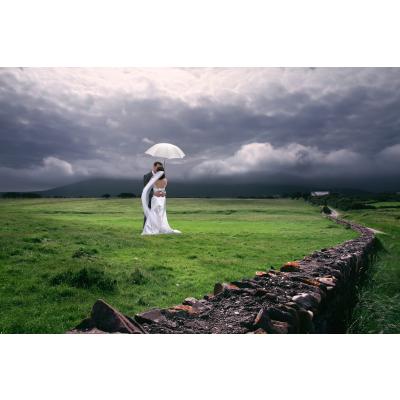
Posted in: World Wedding Customs
 The beauty of Ireland plays a huge role in planning an Irish engagement and wedding. Photo by panimo on Canva.
Traditionally, Irish engagement and marriage followed fairly casual customs. That is, until the church became involved. Of course, even with a casual approach to marriage, traditions arose.
The beauty of Ireland plays a huge role in planning an Irish engagement and wedding. Photo by panimo on Canva.
Traditionally, Irish engagement and marriage followed fairly casual customs. That is, until the church became involved. Of course, even with a casual approach to marriage, traditions arose.
Irish Engagement
Many of the customs surrounding an Irish engagement differ depending on which village or town the couple calls home. For example, in Donegal, when a man decided to wed a woman, he went to her home and threw his cap through the door. His future bride accepted his proposal by keeping the cap. However, a woman could throw the cap back out the door if she wished to refuse his proposition. Throughout Ireland, until the Norman invasion of the late 1100s, marriage was not considered a lifetime commitment. Couples remained wed for at least one year. At the end of the year, they decided together whether they wished to stay together for another year. Today, Wiccan couples follow this same tradition of marriage for a year, although they add an extra day - a year and a day, as they say.An Irish Marriage Contract
Once the Normans arrived, marriage became a legal affair. Marriage law dictated who could and could not get married. For instance, the law forbade an impotent or infertile man to marry. If his impotence was discovered after the wedding took place, his wife could divorce him. Furthermore, the Irish believed an obese man could not perform his marital duties. Therefore, men of great girth were forbidden to marry. Finally, a man without land also could not secure a marriage contract.The Bride Price
Irish law required a prospective groom to pay some kind of bride price to his future in-laws. For example, the coibche. The groom and his future father-in-law agreed upon a sum. Each year, beginning with the first year of their marriage, the man paid his father-in-law this amount of money. From the second year of marriage forward, the man paid a percentage of the coibche to his wife, as well. After each year of marriage, the wife's percentage increased. For those who married outside their kingdom (tuath), grooms amassed a transportable treasury of goods to take to his prospective bride's father. In Ireland, they call this payment a tionnscar. Typically, this payment included gold, copper, silver, or brass.Cooking His Goose
Traditionally, an Irish engagement involved a special meal shared by the groom, his bride, and her family. It began with an invitation to dinner from the bride's parents to the groom. For the meal, the bride's mother cooked a goose. During this decadent meal, tradition dictated that the terms between the couple and the bride's family were confirmed. These terms sometimes involved elaborate agreements between the two parties. As such, the Irish referred to these agreements as The Bindings. The dinner itself carried enough significance that it also received a ritual name called Aitin' the Gander. The Bindings included such issues as to how the couple would care for their parents as they aged. Also, how often they would escort their parents to church on Sundays. Since the agreements were signed while the goose cooked, by the time they sat to eat, there was no way a groom was locked in, unable to back out of the marriage. Hence, the expression, "His goose is cooked." Aitin' the Gander might take place as soon as the couple announced their engagement, or as late as the night before the wedding ceremony. ~Angela Magnotti Andrews5 years ago
37 view(s) 